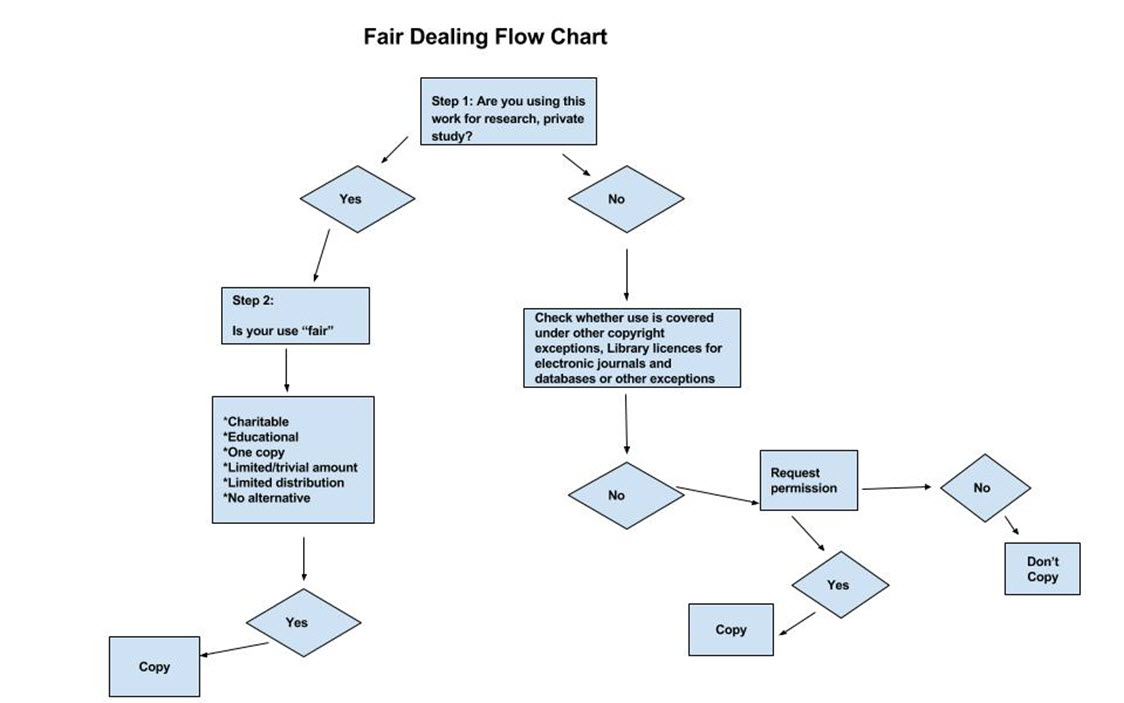- Library
- Research Guides
- Copyright Information & Resources
- Fair Dealing & Flowchart
Copyright Information & Resources
Fair Dealing Chart (PDF)
Fair Dealing
Fair dealing is an exception under the Copyright Act (Section 29) that allows an individual to, within limits, reproduce works without permission or payment. To qualify for fair dealing two tests must be passed.
Test #1: Is the dealing for one of these broad purposes as set out in the Copyright Act?
- research
- private study
- education
- parody
- satire
- criticism
- review
- news reporting
Test #2: The Copyright Act and the Supreme Court of Canada (CCH vs Law Society of Upper Canada, 2004 SCC13) has provided a six-factor test for determining whether a particular use or dealing is fair. These 6 factors are:
- the purpose of the dealing: the purpose must fall within one of the eight broadly defined categories outlined above;
- the character of the dealing: this looks at the number of copies. Making a single copy from a work for each member of a defined group is likely to be fair. this also looks at whether the copy is destroyed after it is used for its intended purpose;
- the nature of the work: Is the work intended to be disseminated widely? Is it published or unpublished?
- the amount or proportion of the copying; how much of the work was copied.
- the effect of the copying on the work: Will the copy compete with the commercial market value of the original work?
- the availability of alternatives: including whether there is a non-copyrighted equivalent available.
Fair Dealing FlowChart
It can often be tricky to determine whether something you want to do falls within fair dealing. This quick guide sets out the steps you should take and the factors you should consider. Ultimately, it will depend on your particular circumstances and you have to make a judgment call as to whether your use can be classified as “fair”.
If you have any doubt, you should ask for permission. If the work is a library-licenced electronic resource, the permissibility of your use is determined by the terms of the licence.
Step 1: Check whether your purpose is a permitted purpose
Are you using the work for the purpose of:
- Research
- Private study
- Criticism
- Review
- News reporting
- Education
- Satire
- Parody
Yes - Continue to step 2
No - Check whether use is covered under:
- Any other Copyright Act exception
- Library licences for electronic journals and databases (Note: some licences may prohibit some uses even if the purpose is one of the above.)
- Cinematograph film licences
- Any other agreement
Step 2: Check whether your use is “fair”
| Nature of the Dealing | Less fair | More fair |
| Purpose | Commercial | Charitable/Educational |
| Character of the dealing | Widely distributed/repetitive | Limited distribution/one-off |
| Importance/amount of work copied | Entire Work/Significant excerpt | Limited/trivial amount |
| Effect of dealing on the original work | Competing with original work | No detriment to original |
| Nature of the work |
Confidential Non-copyright works available |
Unpublished/in public interest No alternative works |
| Available alternatives | Not necessary for purpose | Necessary to achieve purpose |

Fair dealing flowchart by the University of Waterloo Copyright Advisory Committee is licensed under a Creative Commons Attribution-NonCommercial-ShareAlike 4.0 International License.
Fair Dealing Flow chart

Chart adapted from the Fair dealing flowchart by the University of Waterloo Copyright Advisory Committee is licensed under a Creative Commons Attribution-NonCommercial-ShareAlike 4.0 International License.
